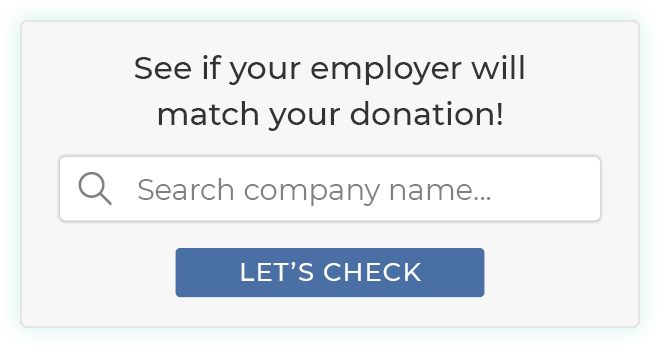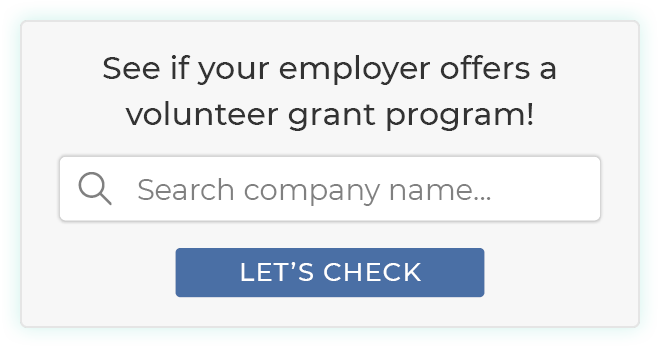Charity auctions are a staple of fundraising events. Whether you’re organizing a live, silent, or online auction (or some combination of the three!), there are ways to remain innovative and fresh while taking on such a classic fundraising strategy.
In this article, we’ll go over a few ways you can combine your charity auction with other popular fundraising techniques to maximize engagement and fundraising dollars:
- Matching Gifts
- Volunteer Grants
- Peer-to-Peer Fundraising
- Remote Participation
Ready to plan the perfect auction? Let’s get to it!

1. Matching Gifts
Matching gifts are a type of corporate giving program in which companies match donations their employees make to eligible nonprofits.
Here’s how corporate matching gifts work:
- A donor makes a gift to a nonprofit.
- The donor submits a request for a matching gift to their employer.
- The employer reviews the request and verifies the donation with the nonprofit.
- The employer provides a matching donation to the nonprofit.
It seems like a great deal, but matching gift programs are often overlooked by both donors and nonprofits. This is generally due to a lack of awareness that the donor’s employer even offers such a program.
But matching gifts can have a huge impact on your auction.
If an auction attendee donates to your cause during the event, and their employer offers a matching gift program, they can submit a request for a match.
How Can You Implement It?
In order to make the most of matching gifts during your auction, consider investing in matching gift software that offers access to a matching gift database. A matching gift database houses information on thousands of companies and their matching gift programs so your donors can easily access the guidelines needed to submit a match request.
Guidelines include:
- Match ratio. Many companies match at a 1:1 ratio (a dollar for a dollar), but others match donations on a range from .5:1 all the way to 4:1.
- Minimum and maximum match amounts. The most common minimum amount is $25, but it can range anywhere from $1 to $100. The maximum match amount typically ranges from $1,000 to $15,000, but can go even further up.
- Submission deadlines. Different company deadlines vary, and you’ll want to be aware of these so your auction guests submit their match requests in time. This may be the end of the calendar year, a set number of months following the donation, or another specific timeframe.
- Nonprofit eligibility. Many matching gift programs match donations to most nonprofits, but sometimes there are restrictions, such as for religious organizations.
- Employee eligibility. An employee’s employment status may impact whether they’re eligible for matching gifts. This may include full-time, part-time, or retired individuals.
With the matching gift software, you can embed a company name search tool directly on your website, which will provide your auction donors with direct access to the database. All they need to do is type in the name of their company, and the search tool will populate the information they need about their employer’s program.

Best Practices
Be sure to promote your matching gift search tool at the same time you promote your auction. You probably already use social media, direct mail, your website, and email to reach your donors. Include matching gift information and a link to the search tool on your website in all your event outreach so attendees can look up their eligibility.
Matching gifts can provide a huge boost in revenue because you’ll earn double the donation you would have otherwise gotten!
2. Volunteer Grants
Focusing on your auction attendees is important, but what about the volunteers who are helping run your event? Did you know that many of them may be eligible for volunteer grants?
Volunteer grants are another form of corporate philanthropy in which companies provide monetary grants to nonprofits where their employees regularly volunteer.
Here’s how volunteer grants work:
- An individual volunteers with a nonprofit.
- The individual submits a request for a volunteer grant to their employer.
- The employer verifies the volunteer hours with the nonprofit.
- The employer sends a check to the nonprofit.
Like matching gifts, volunteer grants are often overlooked due to lack of awareness. But if you run multiple auctions throughout the year, or any kind of event, and the same volunteers help out at each one, it’s important to have them check their eligibility for a volunteer grant.
How Can You Implement It?
Remember the matching gift database we mentioned earlier? Many of these databases also offer information about volunteer grant programs! Direct your volunteers to your website to view your search tool. Once they find their company in the database, it will populate both matching gift and volunteer grant information, if applicable.

Best Practices
Make sure you stay up-to-date with your volunteers’ employer information to determine if they’re linked to any volunteer grant programs. If multiple volunteers come from the same company, they may even be eligible for a team volunteer grant!
Looking for more information? Check out Double the Donation’s guide to volunteer grants.

3. Peer-to-Peer Fundraising
Peer-to-peer fundraising is a social fundraising technique in which your supporters fundraise on your behalf. These fundraisers typically culminate in an event. In this case, that’s your auction!
Here’s how peer-to-peer fundraisers work:
- The nonprofit determines a fundraising goal and sets up its main campaign page.
- The nonprofit recruits volunteer fundraisers to set up their own campaign pages, providing them with resources they can use to promote their pages.
- The volunteer fundraisers share their individual campaign pages with friends and family on a variety of platforms.
- The nonprofit tracks the campaign’s progress and continues offering support.
Peer-to-peer fundraising campaigns increase anticipation as you lead up to your event. If you’re looking for ways to effectively leverage it, read on!
How Can You Implement It?
In order to implement a peer-to-peer fundraising campaign as part of your auction, you’ll want to set a specific fundraising goal for your event. But beyond that, you’ll want to set individual goals to motivate your participants. A specific goal for each participant will give them something to work toward.
Then, throw a little friendly competition into the mix by incorporating gamification techniques. This can help maximize engagement in the lead-up to your auction. Gamification elements, like fundraising thermometers and leaderboards, provide an effective visual to motivate donors and participants to get you to your goal.
As you plan out both your event and your preceding fundraising campaign, remember that both tactics should come together to create one cohesive fundraiser. If you’re raising money for a specific cause (for example, a new school building), make sure that both components reflect that.
During your auction event, call attention to your campaign. If you met or exceeded your goals, celebrate and publicly thank your highest contributors. If you didn’t meet your target or would like to raise more, extend your campaign to include the night of your auction and dedicate time at the event for attendees to make last-minute contributions and receive special rewards for doing so.
Best Practices
Here are a few ways to make your peer-to-peer fundraiser a key part of your auction planning:
- Tell your story with visuals. Make sure you tell your organization's story in an effective way. Share heartwarming stories across your marketing channels and incorporate compelling visuals.
- Recognize your peer-to-peer volunteers. Motivate your volunteer fundraisers by recognizing them and giving them a shoutout when they reach a certain threshold. This is a great way to keep them engaged and raise more.
- Incorporate matching gifts. Individuals are more likely to participate in your peer-to-peer fundraiser if they know their donation will go twice as far. Encourage donors to look up their matching gift eligibility, and you can end up with double the donations!
Peer-to-peer fundraising campaigns are a great technique to pair with your auction. You’ll boost engagement, raise more, and keep your cause at the forefront of your supporters’ minds. Learn more about peer-to-peer fundraising here.
4. Remote Participation
Whether you want to increase participation or you need to convert your live auction event into a virtual auction, offering a way to participate remotely widens your audience and can result in even more revenue.
How Can You Implement It?
Use online bidding features that can be leveraged before or during the event. Showcase all of your auction items in an online catalog to build up hype for the auction itself, while opening the event up to everyone.
It’s important to have a website for your event, as well, which lends you credibility and allows you to effectively promote your auction. This is also where donors can engage with your nonprofit, bid, donate, and share the event on social media.
Best Practices
Be sure to use all of your marketing channels to promote your virtual event. This includes:
- Social media
- Email outreach
- Direct mail
- Your nonprofit’s website
- And more!
The more you promote your virtual event across platforms, the more engagement you’ll build. And if you promote matching gifts as part of your marketing strategy or build in a peer-to-peer fundraising campaign, you’ll be able to boost your revenue and put that toward serving your mission!
Managing an event like a charity auction is a classic way to engage donors and bring in major donation dollars. If you’re looking to add a fresh take on your next auction event, consider pairing it with one of these popular fundraising techniques!
Special thanks to Adam for sharing his expert advice in this article.
Adam Weinger is the President of Double the Donation, the leading provider of matching gift tools to nonprofit organizations and educational institutions. Adam created Double the Donation in order to help nonprofits increase their annual revenue through corporate matching gift and volunteer grant programs. Connect with Adam via email: adam@doublethedonation.com or on LinkedIn.
